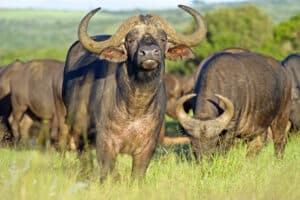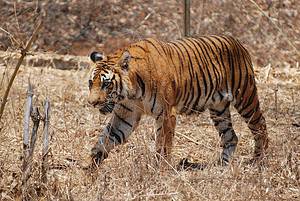The tiger is one of the most popular animals in the world. Sadly, they are all endangered to some degree, and though conservation efforts are underway, they may not be fast enough. Even if enough tigers reproduce in captivity, they may not have anywhere to be released if humans continue taking their habitats and turning them into homes and shopping centers. The number one reason tigers are endangered to such a significant level is because of a lack of habitat and poaching.
By visiting nonprofits like Tiger World in Rockwell, North Carolina, you are supporting conservation efforts. There are organizations you can donate directly to help the conservation effort by way of creating protected areas where the tigers can live in their native countries and provide protection from poaching. Tigers are sold in the wildlife trade to people wanting a cute, fuzzy tiger cub as a pet and other less-than-beneficial markets like “backyard zoos.
6. Bengal Tiger (Panthera tigris tigris)
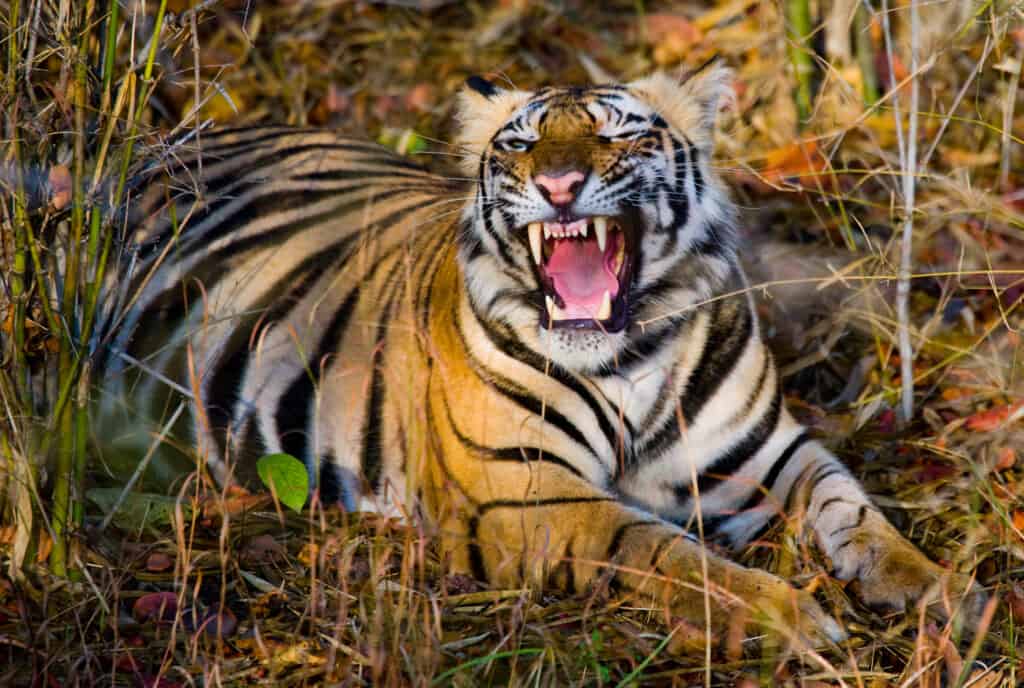
The Bengal tiger has the largest canines of any species of large cat at 4 inches long.
©iStock.com/ANDREYGUDKOV
How Rare: Only 2,603 – 4,000 remain
Appearance: Reddish orange body with black, grey, or brown vertical stripes. The chest and underside are a lighter orange-to-white color.
Size: 220 – 570 pounds, 94 – 120 inches long including tail, and 36 – 42 inches tall at the shoulder
Lifespan: 12 – 25 years
Habitat: Bangladesh, Bhutan, India, and Nepal.Tropical dense forests and mangroves. They require a lot of space to roam in forests, but because of humans developing land, they do not have enough room to live any longer.
Behavior: These tigers love lounging in the water. They are also the biggest cats in the world. No two Bengal tigers have the same stripe pattern. They are solitary creatures who hunt, sleep, and lounge alone. They have the longest teeth at 4 inches than any other tiger.
Diet: Deer, cattle, wild boar, and other large mammals. When they attack, they break the spine of their prey with their sheer force. They are very afraid of people and want nothing to do with us, for good reason.
Bengal tigers make up the majority of tigers alive. They are endangered but not nearly as severe as the other types of tigers. Most Bengal tigers are not purebred Bengals. They have been crossbred with other types of tigers to boost their number in captivity and the wild. Bengals are aggressively poached and sold in illegal animal trades. Conservation efforts are underway.
An extra rare type of Bengal tiger is the white variation. These tigers have solid white fur with black or grey stripes and icy blue eyes.
5. Siberian Tiger (Panthera tigris altaica)
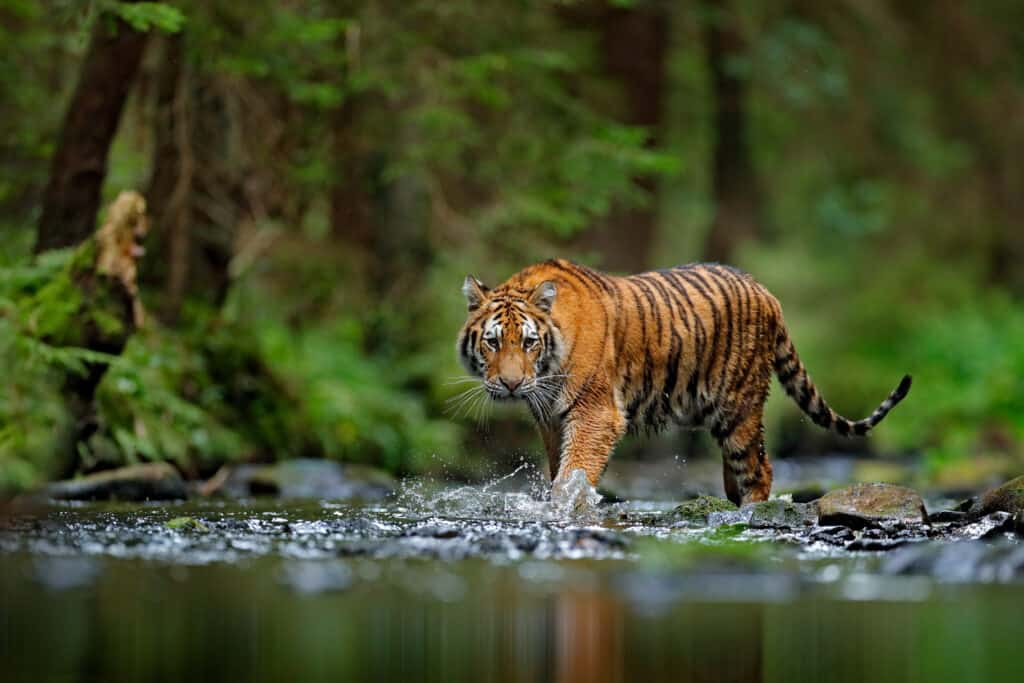
The
Siberian
tiger is in Russia, North China, and Korea. The number in North China and Korea is smaller than what is known to be in Russia.
©iStock.com/Ondrej Prosicky
How Rare: Only 500 – 600 remain in the wild, with an additional several hundred located in zoos and conservation centers.
Appearance: Very thick, muted orange fur with vertical black stripes. The amount of stripes on a Siberian tiger’s fur is considerably less than the Bengal tiger’s. These are cold-climate tigers that tend to have thicker “winterized” coats as compared with tigers in India. They also have manes to help keep them warm. The Siberian tundra can reach -58 degrees in the winter.
Size: 370 – 933 pounds, 32 – 42 inches tall at the shoulder, and 94 – 143 inches long, including tail. The Siberian tiger is the world’s largest tiger.
Lifespan: 12 – 25 years
Habitat: The Far East of Russia, specifically the Amur region.
Behavior: These massive felines are very serious about their solitary lifestyles and mark trees to warn other tigers to stay out of their territory.
Diet: Wild boar, deer, elk, raccoon dogs, badgers, sika, and small Asianic black bears. Once they have successfully caught prey, they drag it off to somewhere secluded before eating. Table for one, please?
The Siberian tiger is sometimes bred with Bengal tigers to benefit both species’ endangered numbers. The Siberian tiger’s status was upgraded from critically endangered to just endangered. Though slight, it is a positive move in the right direction.
Tigers have five times the strength pound for pound as a human athlete.
4. Sumatran Tiger (Panthera tigris sumatrae)
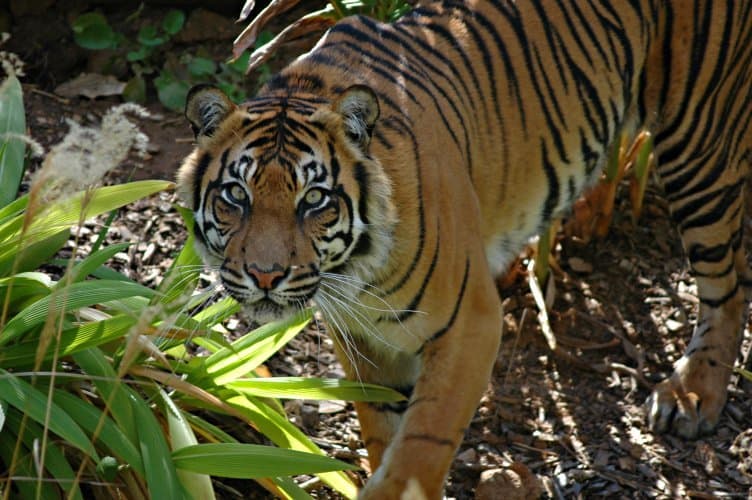
Sumatran tigers’ stripes are similar to the human fingerprint in that no two tigers have the same markings.
©I, Kevin1243, CC BY-SA 3.0, via Wikimedia Commons – License
How Rare: Only 500 – 600 remain
Appearance: They have darker orange fur with stripes that are closer together than other tigers, a short mane, and long fur on their cheeks. They can be identified by the markings on their foreheads. Also, they have webbed toes, which make them fast swimmers. The narrow stripes help to camouflage the tigers in the jungle. The skinnier stripes help them blend in more than tigers with thicker stripes.
Size: 180 – 300 pounds, 29.5 inches tall at the shoulder, and 108 – 144 inches long, including tail. The Sumatran tiger is the smallest of all the tigers.
Lifespan: 15 – 20 years
Habitat: Sumatra, Indonesia, in the rainforest in sub-mountain or mountainous. They spend a lot of time in the water.
Behavior: The Sumatran tiger is the smallest of the rarest tigers. They sleep between 18 – 20 hours a day on average. They sleep all day and hunt at night. The tigers are very territorial and do not let other tigers into their territory unless it’s mating season. Other than when they are with cubs or a mate, the tiger is solitary and marks its territory with urine as domesticated unaltered cats do.
Diet: Monkeys, birds, fish, tapir, deer, boar, and crocodiles. They are stealthy, opportunistic hunters and will eat anything they can catch.
3. Indochinese Tiger (Panthera tigris corbetti)

Indochinese tigers may be extinct in China.
How Rare: Only 350 remain
Appearance: Orange, golden coast with thick black stripes. They have white fur on their underside, face, and neck. These tigers, like the other tigers, have retractable claws like a domesticated cat which makes climbing trees easy. They are also the tallest of the rarest tiger species. The tips of their fur are light-colored, which gives them a ghostly appearance.
Size: 230 – 660 pounds, 91 – 112 inches long, and 30 – 39 inches tall at the shoulder.
Lifespan: 15 – 26 years
Habitat: Subtropical rainforests and grasslands in Southeastern Asia. Bamboo forests help the tiger blend in to stalk nocturnal prey. They live in Cambodia, Laos, Vietnam, Thailand, and Myanmar.
Behavior: The tigers have excellent eyesight and hearing and can run at speeds of 60 mph in short bursts. As they age, their eyesight becomes poor, which leads to issues with hunting and finding enough food.
Diet: Deer, wild boar, monkeys, wild cattle, serow, hog badgers and porcupines. These tigers can eat up to 88 pounds of meat in one sitting.
2. Malayan Tiger (Panthera tigris jacksoni)
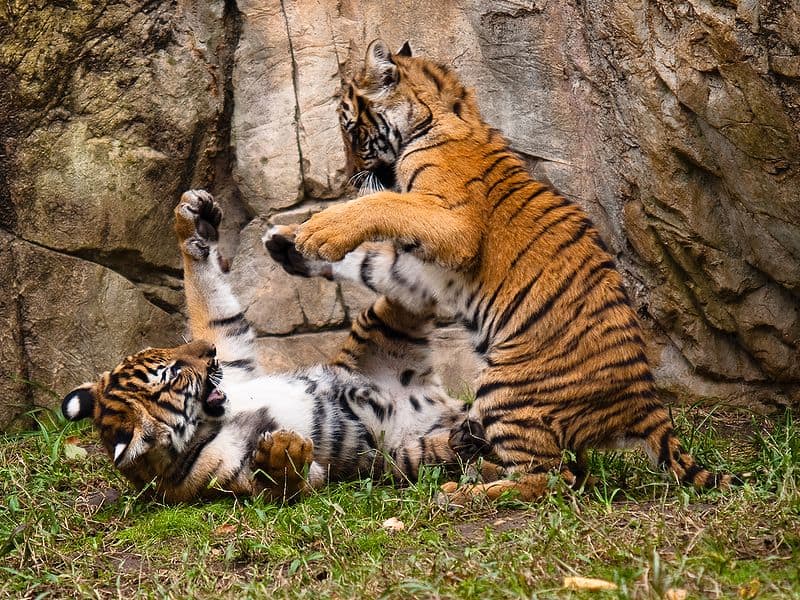
The Malayan tiger is one of the smallest tiger subspecies.
©Malcolm, CC BY-SA 2.0, via Wikimedia Commons – License
How Rare: Only 250 – 340 remain
Appearance: Reddish orange coats, white undersides, white spots on ears, and black stripes.
Size: 165 – 330 pounds, 77 – 96 inches long, and 23 – 41 inches tall at the shoulder.
Lifespan: 15 – 20 years
Habitat: They live in the Malaysian jungles in Southeast Asia; Pahang, Kelantan, Perak, and Terengganu. The tiger is most comfortable in less dense jungles because its stripes help it to blend in and stay hidden. The elusive tigers stay hidden almost their entire lives.
Behavior: The Malayan tigers are the smallest subspecies of tigers. Like the other tigers, they love swimming and also enjoy hiding out in dense jungles and mountains. These cats have excellent eyesight and hearing, which helps to make them excellent nocturnal hunters. They are also able to run up to 40 mph for short distances.
Diet: Their favorite meal of Malayan animals is sambar deer. They also enjoy a menu consisting of barking deer, wild boar, monkeys, Bornean bearded pigs, and serow. They have also been known to dine on sun bears, young rhinoceroses, and sometimes young elephants.
1. South China Tiger (Panthera tigris amoyensis)
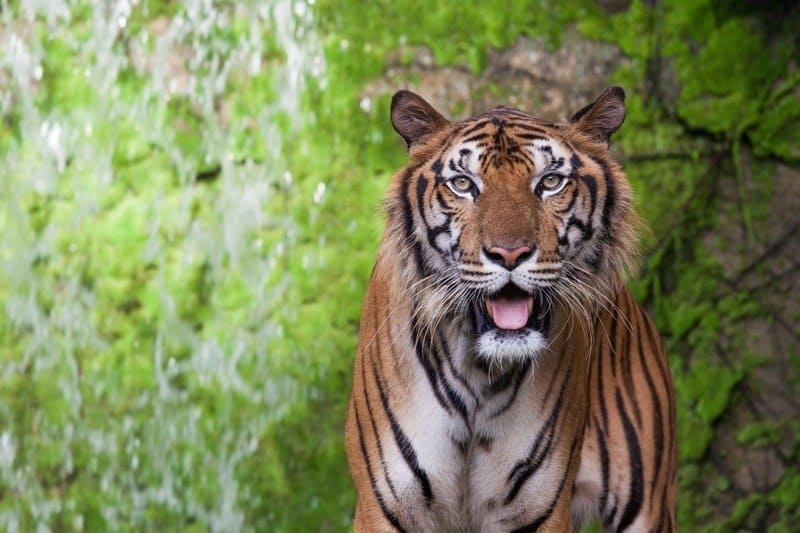
The South China tiger is one of the original tiger species called a “stem tiger.”
©Deer worawut/Shutterstock.com
How Rare: Extinct in the wild. Only 30 – 40 remain in captivity,
Appearance: Smaller, taller, and thinner in appearance than the other tiger subspecies. They are reddish-orange with narrow, close-together black stripes. These are the rarest species of tiger in the world.
Size: 220 – 386 pounds, 87 – 104 inches long, and 36 inches tall.
Lifespan: 20 – 25 years
Habitat: Fujian, Guangdong, Hunan, and Jiangxi provinces in China. They prefer forests and other woodlands.
Behavior: These are small tigers but larger than the Sumatran tigers. They spend a lot of time sleeping through the day and hunting prey at night. They engage in stalking their prey and waiting for the perfect time to attack. The South China tiger is known as a “stem tiger,” which is thought to be one of the originating tiger species and much older than the other subspecies.
Diet: Muntjac, serow, tuft deer, water buffalo, wild boar, deer, grey langur, hog deer, porcupine, hare, and peafowl.
Honorable Mention
Bengal Golden Tiger
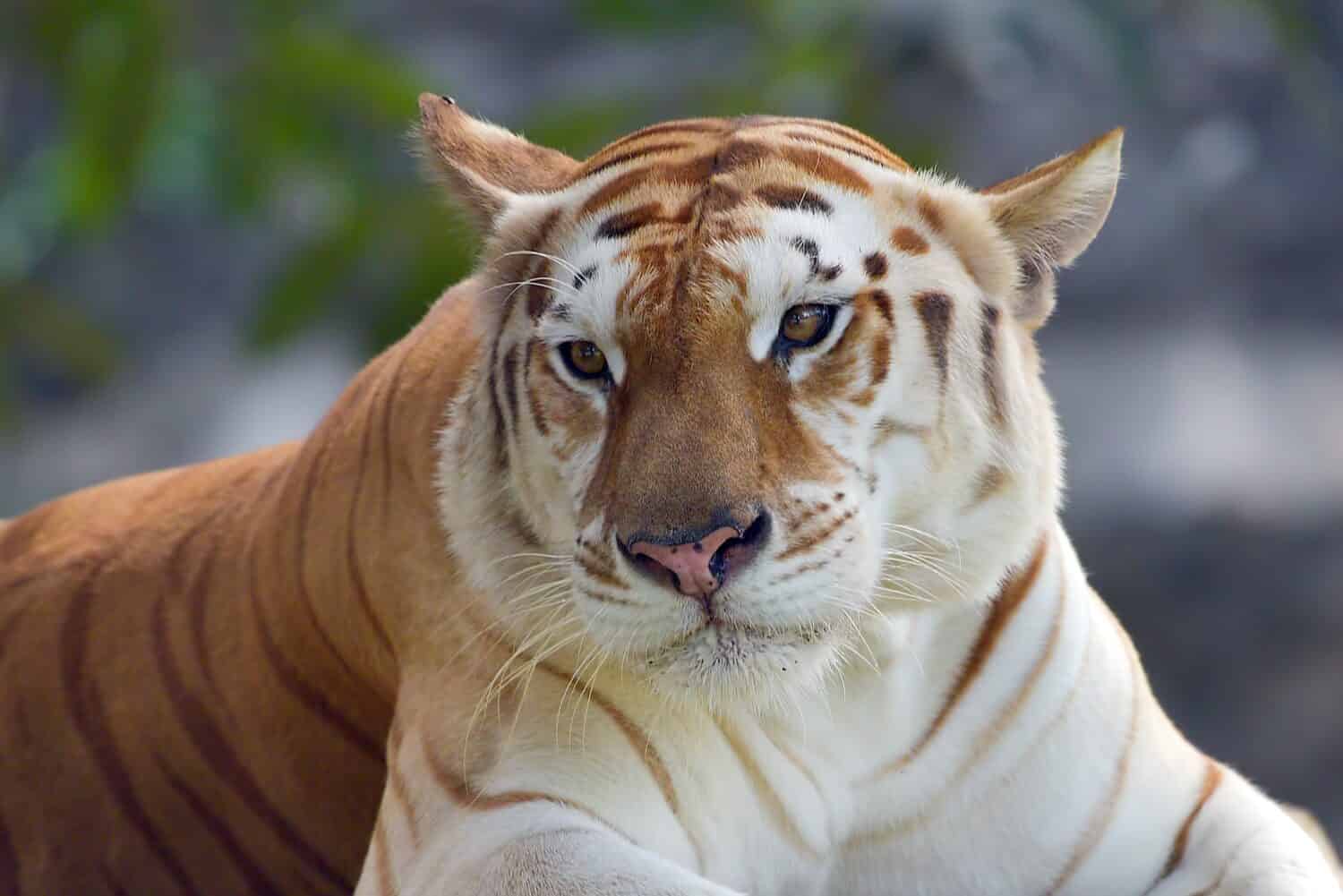
The golden tiger is also sometimes called the golden tabby tiger and the strawberry tiger.
©DSlight_photography/Shutterstock.com
How Rare: Only 30 remain in captivity,
Appearance: Strawberry blond colored fur with darker orange stripes, white chest, neck, and underside. The white on their face and body is a very bright white. Light coloring is a very rare mutation caused by a recessive gene. This color has never been seen in the wild, and only 30 remain in captivity. The gene is called a wide band gene in golden tigers. In white tiger variations, it’s called the chinchilla gene. Their fur is considerably softer than the darker orange tigers. These are some of the rarest tigers in the world.
Size: 300 – 500 pounds, 94 – 120 inches long, and 35 – 43 inches tall at the shoulder.
Lifespan: 15 – 20 years
Habitat: The outer foothills of the Himalayan mountains. Moist, tropical evergreen forests, tropical dry forests, mangroves, mountains, alluvial grasslands, and upland forests.
Behavior: These non-wild big cats are very active and playful. They are very curious. Though they are captive-bred, they are still instinct-driven animals that are not tame.
Diet: Sambar, grey langur, wild boar, hog deer, muntjac, takin, barasingha, chital, gaur, and water buffalo.
FAQ

Q: Are black tigers real?
A: Black tigers are very much real. There is such a thing as a stripe mutation where a tiger’s stripes can be so wide that it makes the tiger appear black instead of orange. Altered tape genes, responsible for causing blotchy tabby patterns in cats, are what’s responsible for black stripe mutation.
Q: Did white tigers ever exist in the wild?
A: Not anymore. The last white Bengal tiger was shot by a trophy hunter in 1958. There are around 200 white tigers in captivity. The white tigers in captivity are not naturally occurring and it should not be celebrated. They are white from nine generations of inbreeding. The gene mutation is called leucism. The only tigers capable of producing white fur are Bengal tigers, though none exist any longer.
Q: Do blue tigers exist?
A: None exist currently. A blue tiger was born at an Oklahoma zoo in the 1960s and the body was preserved. The tigers are not “blue” in a typical sense but are Maltese tigers, which were naturally slate grey, giving them a bluish look. They had dark grey or black stripes just like the usual tiger. It has been questioned whether or not the tiger was truly Maltese or if it was a Siberian or South China tiger.
The photo featured at the top of this post is © DSlight_photography/Shutterstock.com
Thank you for reading! Have some feedback for us? Contact the AZ Animals editorial team.




